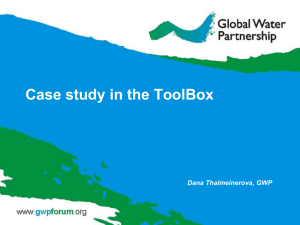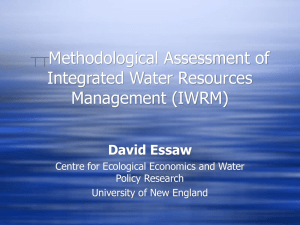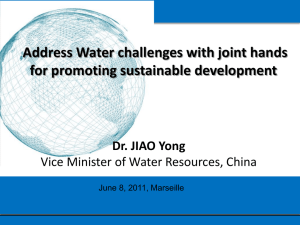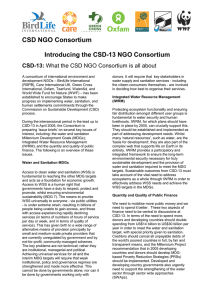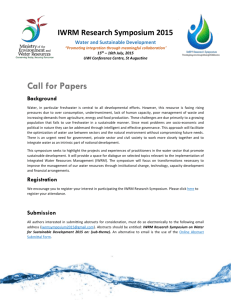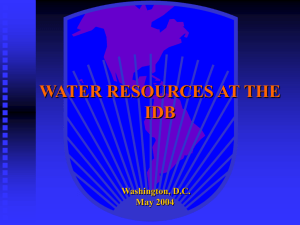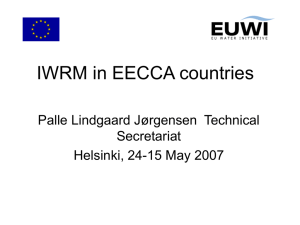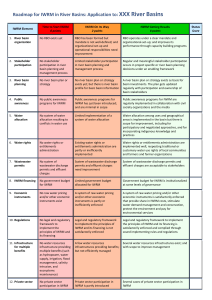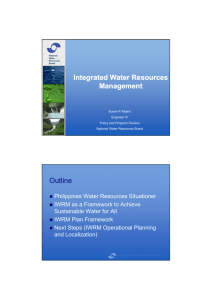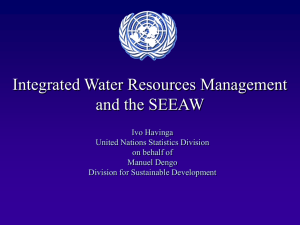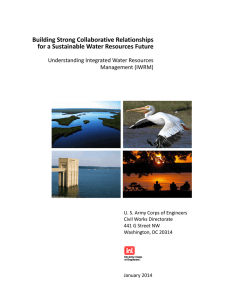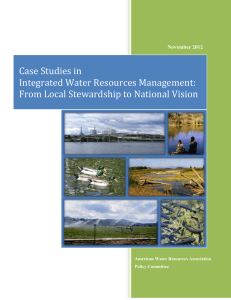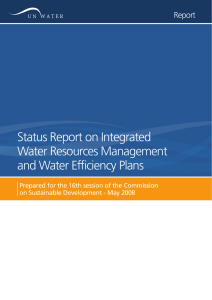CSD NGO Consortium Integrated Water Resource Management CSD-13:
advertisement
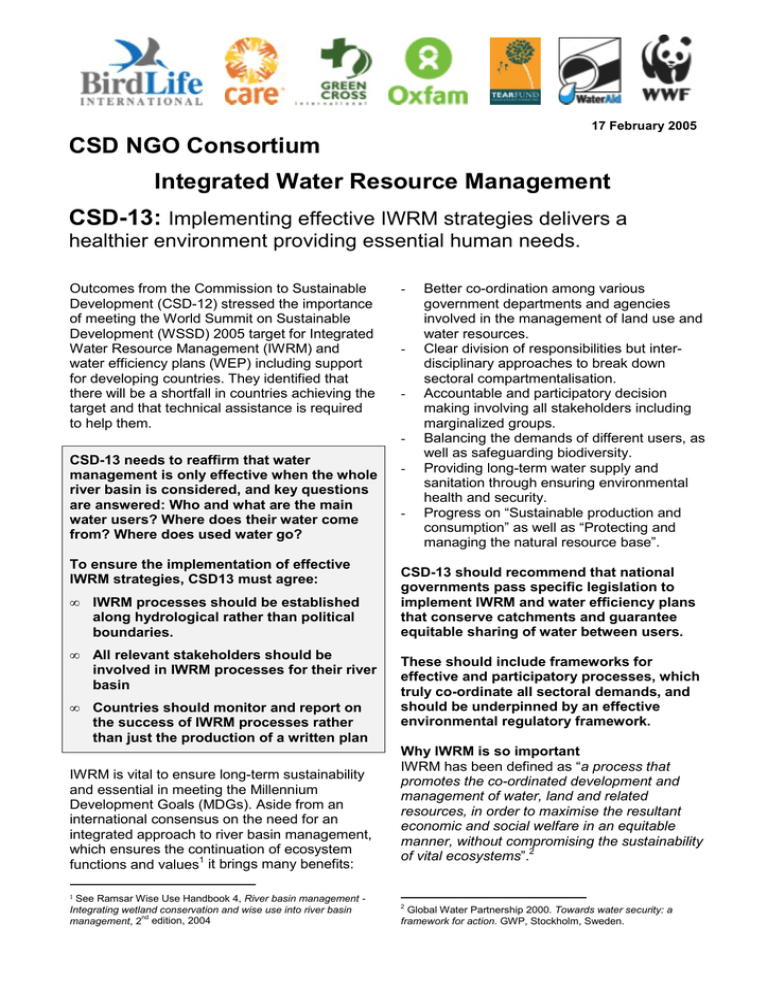
17 February 2005 CSD NGO Consortium Integrated Water Resource Management CSD-13: Implementing effective IWRM strategies delivers a healthier environment providing essential human needs. Outcomes from the Commission to Sustainable Development (CSD-12) stressed the importance of meeting the World Summit on Sustainable Development (WSSD) 2005 target for Integrated Water Resource Management (IWRM) and water efficiency plans (WEP) including support for developing countries. They identified that there will be a shortfall in countries achieving the target and that technical assistance is required to help them. - - - CSD-13 needs to reaffirm that water management is only effective when the whole river basin is considered, and key questions are answered: Who and what are the main water users? Where does their water come from? Where does used water go? To ensure the implementation of effective IWRM strategies, CSD13 must agree: • IWRM processes should be established along hydrological rather than political boundaries. • All relevant stakeholders should be involved in IWRM processes for their river basin • Countries should monitor and report on the success of IWRM processes rather than just the production of a written plan IWRM is vital to ensure long-term sustainability and essential in meeting the Millennium Development Goals (MDGs). Aside from an international consensus on the need for an integrated approach to river basin management, which ensures the continuation of ecosystem functions and values1 it brings many benefits: See Ramsar Wise Use Handbook 4, River basin management Integrating wetland conservation and wise use into river basin management, 2nd edition, 2004 - - Better co-ordination among various government departments and agencies involved in the management of land use and water resources. Clear division of responsibilities but interdisciplinary approaches to break down sectoral compartmentalisation. Accountable and participatory decision making involving all stakeholders including marginalized groups. Balancing the demands of different users, as well as safeguarding biodiversity. Providing long-term water supply and sanitation through ensuring environmental health and security. Progress on “Sustainable production and consumption” as well as “Protecting and managing the natural resource base”. CSD-13 should recommend that national governments pass specific legislation to implement IWRM and water efficiency plans that conserve catchments and guarantee equitable sharing of water between users. These should include frameworks for effective and participatory processes, which truly co-ordinate all sectoral demands, and should be underpinned by an effective environmental regulatory framework. Why IWRM is so important IWRM has been defined as “a process that promotes the co-ordinated development and management of water, land and related resources, in order to maximise the resultant economic and social welfare in an equitable manner, without compromising the sustainability of vital ecosystems”.2 1 2 Global Water Partnership 2000. Towards water security: a framework for action. GWP, Stockholm, Sweden. Water sources that are reliable, both for their quantity and quality, are a prerequisite for the survival of human civilization and socioeconomic development. IWRM is thus a fundamental basis for providing the long-term environmental security necessary for sustainable development and the provision of water and sanitation required to meet the MDGs. international donors funding all major water related projects, including those for agriculture. Throughout the world, the poor management of land and water resources in many river basins has led to major floods, water shortages, pollution and loss of biodiversity, causing massive economic and human losses and damaging the life support systems of the planet. PRSs Failure to prioritise water and sanitation in poverty reduction strategies (PRSs) should not be a barrier to aid funding as WSS targets are global targets to which all governments have signed up. There is a duty for donors to ensure support for them, including IWRM implementation, by securing active support of all actors of the society including civil society and local authorities, particularly as the poor often highlight water and sanitation as key issues, and the poor are those most affected by environmental degradation. CSD-13 should highlight that with human demands and impacts increasing, the fundamental goal of sustainable utilisation of freshwater resources will not be met unless water is transparently managed in river basins, and its distribution and use from source to sea is understood. GETTING IWRM STRATEGIES AND PROCESSES IN PLACE Sharing good practice There is a clear need to share and learn from good practice and knowledge. River basins (also referred to as catchments or watersheds) are the only way through which to plan the management of water. The basis for much of the planning so far has been work done by the Global Water Partnership (GWP); however given the important hydrological and ecological functions of wetlands, it is essential that they be better and more explicitly incorporated into river basin management.1 The International Wetlands Convention (Ramsar) with its 142 parties has adopted guidance and tools to help deliver this under its provisions for 'wise use' of water resources.1 CSD-13 should reaffirm the CSD-6 recommendation providing support for implementation of the Ramsar Convention and further encourage co-operation between the Convention and others working towards IWRM and water efficiency plans. Donor Finance A firm commitment to deliver and implement an IWRM plan should be a prerequisite of Donors must also provide resources for longterm education and capacity building, which is so crucial in developing the necessary expertise to make sustainable decisions about water resources. CSD-13 should recommend increased aid allocations and support for MDG-based PRSs, which fully address the significance of MDG-7 ensuring environmental sustainability. IWRM is crucial to this. MAKING IWRM STRATEGIES EFFECTIVE Integrated sector-wide approaches GWP has noted that “The water crisis is often a crisis of governance: a failure to integrate policies and practices related to the management of water resources.”2 Further, the Millennium Ecosystem Assessment suggests that a single sector approach to achieving the MDGs risks compromising the viability of the very ecosystem services on which improvements in human well-being depend.3 CSD-13 should call for appropriate institutional processes to be established by governments to ensure co-ordination across ministries, bringing together agencies and stakeholders including those responsible for water, sanitation, environment, health, agriculture, forests, finance, business, industry and education. 3 For example, draft MA wetlands synthesis report, at www.millenniumassessment.org/en/products.chapters.aspx Institutional co-operation and improved governance As IWRM plans should be formulated at the river basin/catchment level, this often necessitates regional, national and international cooperation. This should be encouraged, and effective laws and regulations in the participating countries should support this. Stakeholder engagement and using appropriate solutions Stakeholder engagement with equity in participation and decision-making is key to appropriate decisions and successful implementation. Experiences must be shared, past mistakes learned from and successes replicated. CSD-13 should call for cooperation between states sharing transboundary watercourses, including groundwater, and call on States which have not yet ratified the United Nations Convention on the Law of the NonNavigational Uses of International Watercourses to do so. Appropriate solutions and ‘soft’ engineering techniques should be used as much as possible to provide water supply and sanitation, which can benefit from natural services such as filtration. Many developed countries now have to remedy inappropriate hard engineering at huge cost, e.g. infrastructure along the Mississippi. Valuing natural systems Freshwater ecosystems occupy less than 1% of the earth’s surface, not only sustaining life but providing goods and services of enormous value. Water supplies are dependent on these ecosystems, including their biodiversity, which naturally capture, filter, store and release water – such as wetlands, forests and soils. Inland wetlands have been estimated to provide services worth US$2 - 5 trillion. Sustainable work or working sustainably with natural systems has been shown to be extremely cost-effective and to be locally appropriate time and again. However, over half the world’s wetlands have been destroyed or heavily altered in the past 100 years. There are currently 2981 threatened species listed under the freshwater biome on the IUCN Red Data List,4 and negative trends are increasing.5 IWRM can help redress this, also contributing to the global target to significantly reduce the rate of biodiversity loss by 2010.6 CSD-13 should encourage the full valuation of ecosystems (economic, social and environmental) and the use this information in water resource planning. 4 IUCN Red Data List of Threatened Species, 2004 at www.redlist.org 5 Living Planet Report, WWF, 2004. 6 Strategic Plan of the Convention on Biological Diversity (CBD) 2002, and Johannesburg Plan of Implementation, WSSD 2002. CSD-13 should encourage appropriate technology, often small-scale solutions, such as rainwater harvesting and compost toilets, especially in rural areas. Education and awareness-raising This is crucial, particularly for water demand management and managing land and water in an environmentally sustainable way, linked to health, well-being and long-term sustainable development. It should be supported by regulatory tools such as the “polluter pays”, “user pays”, associated with initiatives preventing pollution at sources with safeguards for the poorest. Effective IWRM strategies and water demandside management, saving and efficiency plans and processes will help ensure that today’s development successes don’t become tomorrow environmental failures, costing us all - and especially the poor dearly. For more information, please contact: Jo Phillips* BirdLife International (RSPB, UK Partner) Email: joanna.phillips@rspb.org.uk Websites: http://www.rspb.org.uk; and http://www.birdlife.net Jay Goulden Care International UK Email: goulden@ciuk.org Website: http://www.careinternational.org.uk Bertrand Charrier Green Cross International Email: bertrand.charrier@gci.ch Website: http://www.greencrossinternational.net Joanne Green Tearfund Email: joanne.green@tearfund.org Website: http://www.tearfund.org Antonio Hill Oxfam GB Email: ahill@oxfam.org.uk Website: http://www.oxfam.org Stephen Turner WaterAid Email: stephenturner@wateraid.org Website: http://www.wateraid.org Chris Williams WWF Living Waters Programme Email: chris.williams@wwfus.org Website: http://www.panda.org/about_wwf/what_we_do/ freshwater/index.cf * Lead author of this brief.
